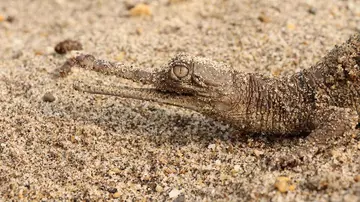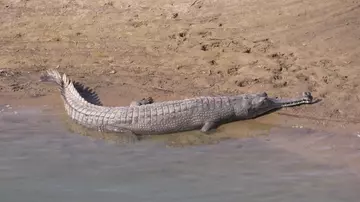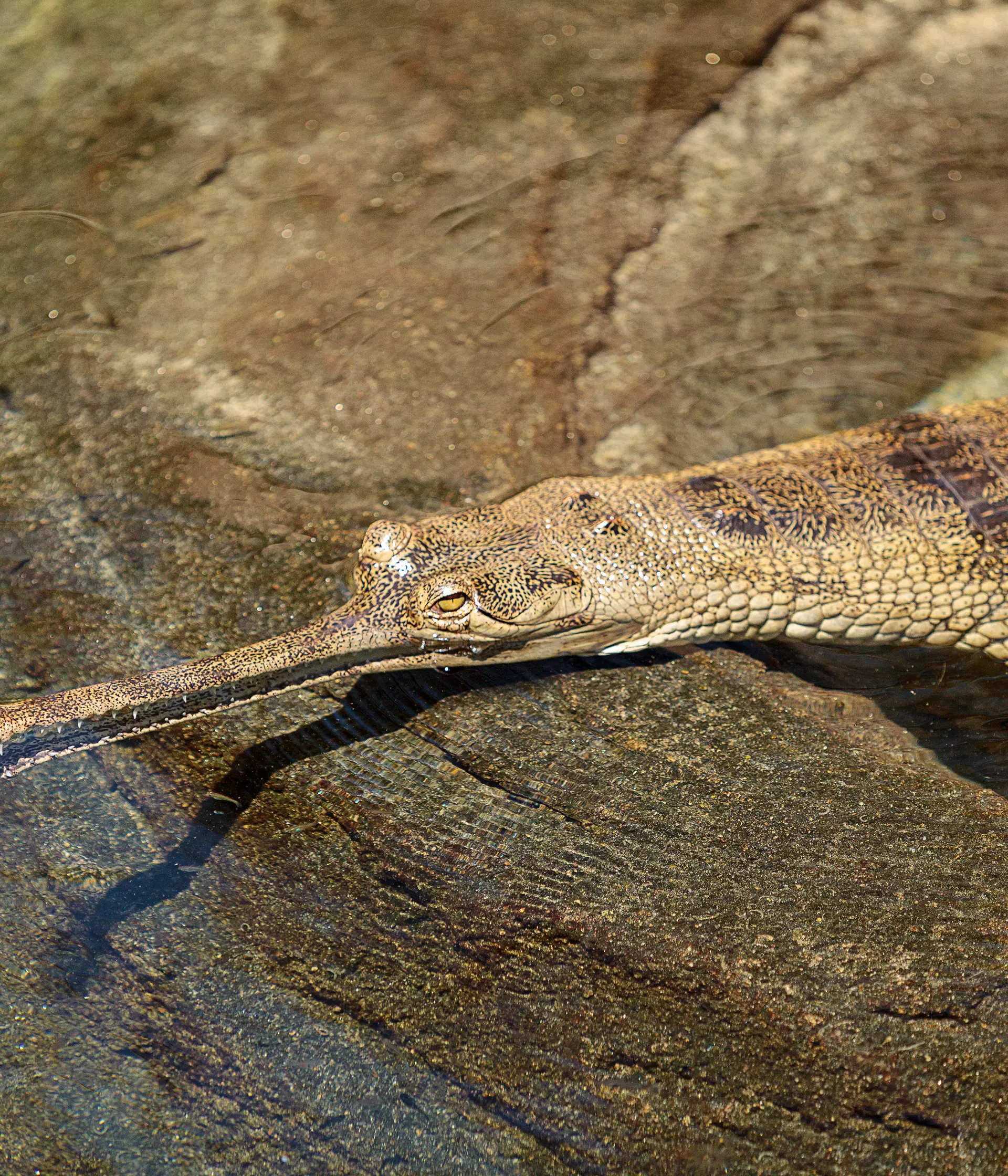
The gharial is an unmistakable, Critically Endangered crocodile.
With only around 200 remaining in Nepal, similar numbers in India, and virtually extinct across the rest of its former range, they are among the world's most endangered reptiles. Gharials are large, with males able to reach over 5m in length and 250kg in weight, with a long narrow snout. While delicate-looking, their snout is the perfect tool to catch fish and crustaceans in the South Asian rivers gharials call home.
Uniquely, male gharials also develop a large distinctive lump on the end of their snouts when they reach sexual maturity, known as a 'gharas' (after a traditional India pot), which gives gharials their name. The uniqueness of the species, and extreme threats to it, are behind its ranking as the 15th most Evolutionarily Distinct and Globally Endangered (EDGE) reptile.
Why are gharials and wetlands threatened?
Freshwater ecosystems have suffered catastrophic declines in biodiversity. Unfortunately, gharials demonstrate how severe this can be, as since the 1940s gharial populations have declined by an alarming 98%, from up to 10 000, to the tiny populations remaining today.
The dramatic declines were initially caused by over-hunting for skins, egg collection and killing by fishermen; however, these threats have now been overtaken by the overwhelming and irreversible loss of riverine habitat, due to construction (of dams, irrigation canals and artificial riverbanks), sand-mining, pollution, and agriculture (both cultivation along river banks, and livestock). These threats have severe impacts on wetland habitats, and in the last fifty years Nepal has lost almost twice as many freshwater species and terrestrial species.

ZSL focuses on Nepal’s two largest populations of gharials, in the Rapti and Narayani rivers of Chitwan National Park, Nepal (a UNESCO World Heritage Site). Around 166 gharials in these two sites are threatened by pollution from mining activities and declining fish populations (which also harm other wetland species), compounded by direct killing, both through becoming trapped in fishing nets, and egg collection. To turn their fortunes around depends on local communities becoming conservationists, using their local knowledge to help gharials to recover.
But communities are facing their own challenges. Around 260,000 people in the buffer zone of Chitwan National Park are heavily dependent on natural resources for their day-to-day livelihoods, not least relying on fishing to provide their food. However, communities are fishing so much that the fish populations are dropping. This is having severe consequences for communities, with a day’s fishing yielding less and less fish over time.

What is ZSL doing to help?
ZSL and its partners (listed below) have been working to turn these challenges into a new opportunity for people and gharials across the buffer zone of Chitwan National Park. If local communities patrol their river system both protecting gharials from poaching and egg collection, and preventing unsustainable fishing and other activities, then fish populations and the wider ecosystem would recover. This would provide a secure source of food for people and gharials.
Gharial Guard Groups
To achieve this, ZSL and partners have worked with local communities to establish ten ‘Gharial Guard Groups’. These innovative community-conservation teams are patrolling their local area regularly, protecting gharials from direct threats and preventing unsustainable fishing and other harmful activities. They are also helping their own communities to understand of the importance of a healthy ecosystem for fishing livelihoods.
This innovative, community-based approach enables local communities’ immense ‘local ecological knowledge’ to be harnessed for conservation. It enables the Gharial Guard Groups to conduct targeted patrolling where it is needed most. For example, they can strategically decide where to patrol, based on gharial habitat distribution, good fishing grounds and the depth of their local knowledge of the wider freshwater ecosystem.
Making use of this local know-how, ZSL and partners have completed the first local ecological knowledge survey for gharials in Chitwan National Park, which has provided key information on their status and threats. With these community-based conservation initiatives now established, some of the building blocks of long-term gharial recovery are in place. ZSL and partners will continue to support and expand these initiatives to ensure their potential is realised.
EDGE Programme
ZSL's EDGE of Existence programme is also helping to build capacity in-country to protect gharial, with three National Geographic Photo Ark EDGE Fellows based across Nepal and India funded by the EDGE Fellowships. Their work invovles overseeing a number of active research and conservation projects on the species.
Learn more about their specific projects below:
Key species
- Gharials (Gavialis gangeticus), Critically Endangered
- Burmese Python (Python bivittatus) Vulnerable
- Mugger (Crocodylus palustris) Vulnerable
People involved
- Dr Hem Sagar Baral, Project Leader and Nepal Country Manager
- Bhogendra Rayamajhi
- Phoebe Griffith
- Sailendra Raj Giri
Partners and sponsors
- The Department of National Parks and Wildlife Conservation (DNPWC)
- The National Trust for Nature Conservation
- Himalayan Nature
- The project is funded by the Darwin Initiative
Related projects
- ZSL's work across Nepal
- Involving communities in the fight against wildlife crime
- Greater one horned rhinos and grasslands
News & Blog links
When nature loses, we all do. Join us on our fight for the natural world, spanning every continent from the depths of the Antarctica to the Sahara desert.
